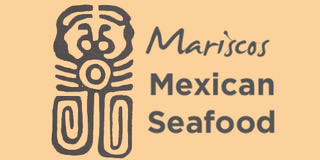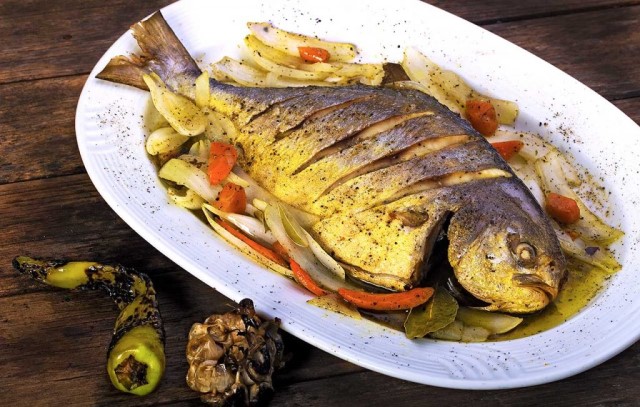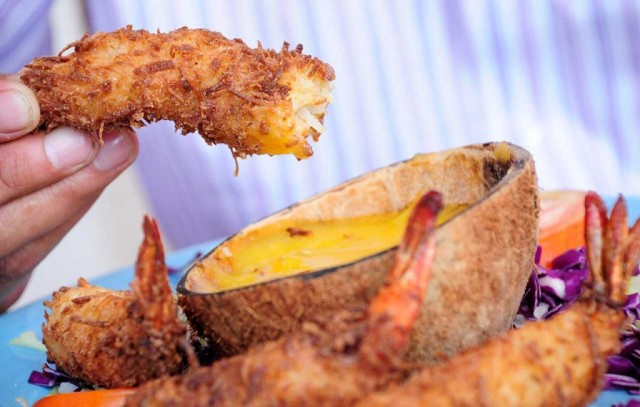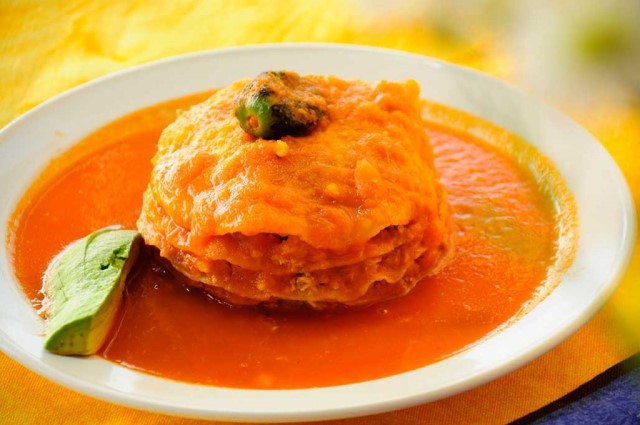
Imagine a place where you can drive for more than 40 miles between a lagoon and the Gulf of Mexico, where humble houses on the side of the road sell crab meat by the kilo and on the road’s speed bumps you can buy fresh prawns, bags full of green habaneros, or the largest shrimp you’ve ever seen. A place where they also handweave the finest “Panamá” hats, where the sky at night is illuminated by the fires of oil wells and sugarcane fields during the harvest season. This is Campeche, a state covered by jungle in eighty percent of its territory.
The food in Campeche couldn’t be less dramatic. Abundance and variety would be the most humble (but the best) description for it. Corn—in all the forms it can take—milpa vegetables, tropical fruits, and seafood are the foundations of the regional gastronomy. Corn may take the form of atole, pozol—a drink made of ground double boiled corn and cacao—tamales, and the ubiquitous tortilla. The milpa provides vegetables and tropical fruits—coconut, pineapple, watermelons, cantaloupes, mangos, bananas, papaya and avocados. Sugarcane, rice, sorghum, and beans are the main crops of commercial agriculture. Lagoons and the ocean produce an assortment of species like cazón (or dogfish) (Galeorhinus galeus), jurel (or white trevally) (Pseudocaranx dentex), pámpano (or blue butterfish; Stromateus fiatola) lubina (or sea bass; Dicentrarchus labrax), sierra (Scomberomorus maculatus), perca o meagre (Argyrosomus regius), and red octopus (Octopus maya) that are indigenous to this region, as are crabs, prawns, oysters, and last but not least the famous Campeche shrimp.
This wealth of ingredients and the creativity of the people of Campeche have produced its own gastronomy. One that includes famous dishes like Pan de Cazón, Camarones al Coco and Pescado en Escabeche (recipes below); delicacies that are not easy to find outside of the state.
And there is also Campeche City, the walled State Capital, inscribed in 1999 on the World Heritage List by UNESCO as the Historic Fortified Town of Campeche. An example of the military architecture of the 17th and 18th centuries, when the Spaniards sought to protect the port from pirate attacks. The perfect setting for a novel or a film…
The most representative fish of the region is cazón. Due to its hard texture, it can be fried, grilled, and used as filling for a variety of corn creations such as empanadas, salbutes, panuchos and pan de cazón—the flagship dish of the state. It’s also used as stuffing for chile Xcatic. Pámpano can be prepared empapelado wrapped in banana leaves and baked or grilled, cooked in green salsa and en escabeche. The roe of lisa (Liza Spp.) is a much sought after delicacy and it’s cooked in multiple ways; catfish en pipian is not for weddings anymore and pámpano poc chuc (marinated with white recado of Mayan heritage) is both an ancient and an exotic dish.
Campeche adjoins in the north with the State of Yucatan, east to Quintana Roo, south with Guatemala and Belize and southeast with the State of Tabasco. Its strategic location keeps it connected in every direction to other wonderful worlds, sources of other gastronomic influences (as if they didn’t have enough).
But what is behind all this abundance and variety? Big rivers that flow into the ocean where the topography allows the formation of lagoons, creating rich ecosystems where fish and shellfish, birds, and a variety of mammals prosper due to the tropical climate, where the minimum temperature never goes below 64 Fahrenheit. Any year the State of Campeche can receive up to 78 inches of rain, no wonder Laguna de Términos—the largest lagoon in Mexico—occupies 495,940 acres next to the Gulf of Mexico!
And what can we say about the people? “Campechano,” literally from Campeche, is a term widely used in Mexico and has several meanings. It can be applied to food and drinks; you can order a taco campechano which will have at least two types of filling, you can order a Cuba Libre Campechana which means rum with Coke and mineral water. Order a Coctel de Mariscos Campechano and you will get a coctel with shrimp plus other shellfish. And you can say that a person “es muy Campechano” or “Campechana” if that person is very open and friendly. Without a doubt, the people from Campeche are just that: very open and friendly.
The State of Campeche is also home to the Calakmul Biosphere Reserve, the largest rainforest reserve in Mexico. It was established as a natural protected area in 1989 and it has been a UNESCO World Heritage site since 2002. Occupying 25% of the state’s territory, it is a refuge for countless indigenous species of plants and animals, a vast jungle sprinkled by lagoons, rivers, and Mayan ruins, most of them in the form of monticules waiting to be unearthed. Well, looking for an adventure trip rich in history, culture and great food? We’ve just made you a suggestion…
Recipes from Campeche
Pámpano en Escabeche

A seafood delicacy with a contundent Spanish influence and easy to prepare.
Ingredients
- 1 whole fish (around two lbs). cleaned and marked (a few cuts on the sides)
- Lemon juice
- Olive oil
- Salt to taste
For the escabeche
- 1 cup olive oil
- 3 onions finely sliced
- 1 garlic head, roasted and cut in half
- 3 chiles Xcatik roasted, skin removed. Substitute: chile guero
- 1 bell pepper roasted or grilled, seeded and sliced
- 5 black peppercorns
- 1 small cinnamon stick
- 2 fresh oregano sprigs
- 2 bay leaves
- 2 cloves
- 1 pinch of cumin
- 1 ½ cups Seville (bitter) orange juice. Substitute: ½ sweet orange plus ½ white vinegar
- salt to taste
- For garnish you may use roasted cherry tomatoes and roasted cambray onions
Instructions
- In an oven dish, rub the olive oil, lemon juice and salt on the fish.
- Roast it in the oven for 10 minutes at 350 degrees F. Reserve.
- In a frying pan, heat the oil and sautée the onions, garlic, chiles and the bell pepper strips.
- Add the herbs, spices and the orange juice. Boil the mixture for 10 minutes.
- Add to the fish and roast for another 10 minutes and it will be ready to serve. Garnish it with the cherry tomatoes and cambray onions. Buen provecho!
Yield: 4 portions
Heat scale: medium to hot
Camarones al Coco

An interesting and delicious combination of ingredients that reminds us of Southeast Asia but the main ingredients (shrimp and coconut) are from this continent. While the milk and wheat flour are of European origin, the technique was perhaps imported from the Philippines.
Ingredients
- 24 jumbo shrimp (21/25) headless, shelled, deveined. Keep the tails.
- lemon juice
- salt to taste
For the batter
- 8 oz. all-purpose wheat flour
- 2 eggs
- milk
- salt
For the breading
- 1 ½ cups grated coconut, dry and sweetened
- 1 cup corn flakes
- frying oil
- garnish with tropical fruit compote
Instructions
- Prepare a plate with a thick layer of flour where you will roll the shrimp. Reserve.
- Prepare the batter beating the eggs with the flour adding the necessary milk and salt to form a thick but runny mix. Reserve.
- Prepare a plate with the crushed corn flakes and mix them with the coconut. Reserve.
- Submerge the shrimp for a couple of minutes in the lemon juice. Drain. Powder them with flour and pass them through the batter, then roll them in the mixture of crushed corn flakes and coconut. Have a frying pan with hot oil ready and fry the shrimp for about three minutes. Drain in a paper towel and serve with the tropical fruit compote. Enjoy!
Yield: 4 portions
Pan de Cazón

This dish could be described as the “lasagna” of Campeche since it is formed by layers of fried tortillas with shredded cooked fish and refried beans in between, all covered with a tomato sauce spiced with habanero.
Ingredients
- 1 ½ lbs. white fish cooked (boiled or roasted) and shredded
- 12 corn tortillas fried
- 2 cups refried black beans
- 2 tomatoes chopped
- ½ onion chopped
- 2 garlic cloves minced
- 1 sprig epazote
- salt to taste
- frying oil
For the tomato sauce
- 4 tomatoes chopped
- ½ onion
- 1 garlic clove
- 1 to 2 chiles habaneros chopped (optional)
- salt to taste
- frying oil
- garnish with avocado slices
Instructions
- Sautée the tomatoes, onion, garlic and epazote in a pan. Add the shredded fish and sautée for a minute or two. Reserve.
- Spread the tortillas with the beans on one side and add the fish over it. Cover with another tortilla and repeat until you have a pile of three tortillas.
- Cover with the tomato sauce which you prepare running through the blender the sauteed tomatoes, onion and garlic and habaneros (if desired). Garnish with avocado slices.
Yield: 4 portions
Heat scale: medium to hot
Note: recipes and photos courtesy of Tourism Department of the State of Campeche. You may follow them on social media at Facebook Sectur Campeche, Instagram @SecturCampeche, and Twitter @Campechetravel1






